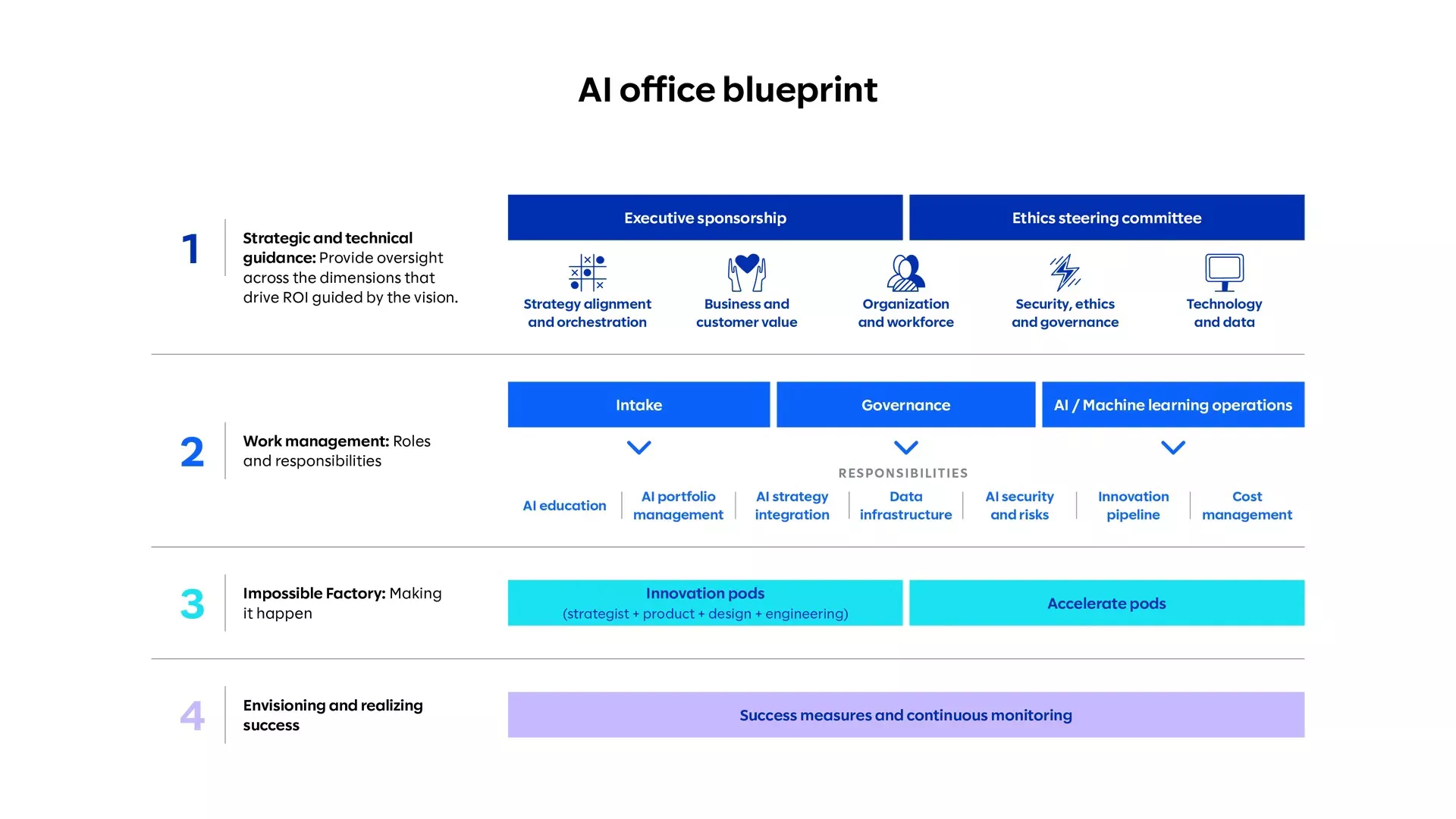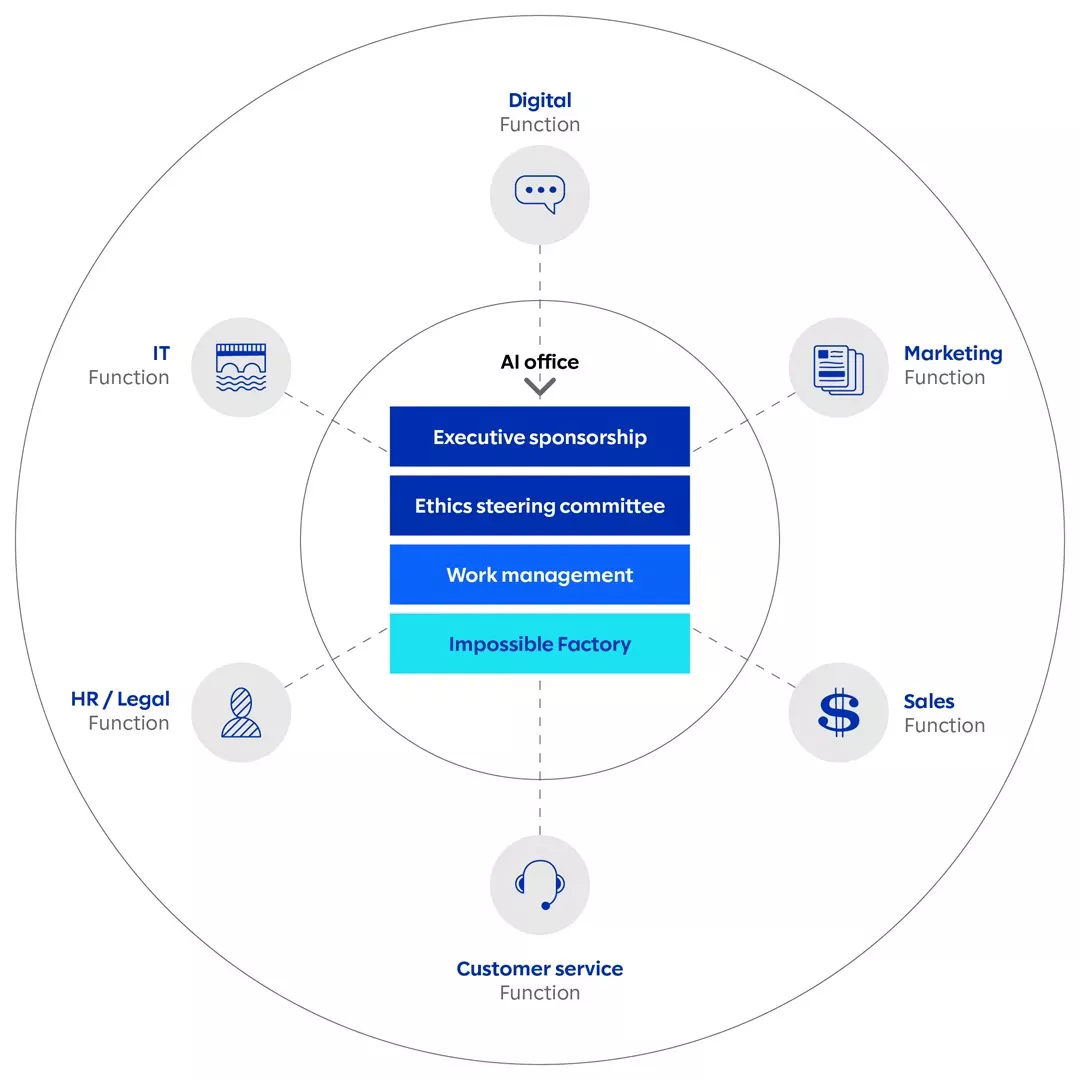Building a sustainable AI office for long-term organizational success

A new era of possibility
AI technologies—particularly machine learning (ML) and deep learning—are evolving rapidly, leading to significant breakthroughs. This fast pace of development requires businesses to adapt quickly for effective integration into their operations. AI diverges from traditional digital transformations in that it is more exploratory in nature. This necessitates a strategic approach not only to its use and application but, more importantly, to its management.
In this article, we explore how the evolving relationship between humans, machines, and work is complicating business operations, and propose the establishment of an AI Office, detailing its structure, implementation, and integration into businesses using a hub-and-spoke model.
The challenge of human-machine synergy
Unlike previous digital transformations, which were more linear and technology-focused (like cloud computing or data warehouses), today’s AI integration involves a dynamic interplay between human creativity and machine intelligence. The biggest challenge we face is in synergizing human capabilities with the efficiency and speed of machines. This involves using AI and technology to augment, rather than replace, human potential. AI excels at processing and analyzing large volumes of data rapidly, but it lacks the creative and emotional intelligence inherent to humans. These human qualities are indispensable for interpreting complex data, making nuanced decisions, and driving innovation.
To fully leverage AI’s capabilities, leaders must move beyond traditional command-and-control models, fostering a culture of adaptability, empowerment, and proactive change management. It’s essential to recognize and leverage the distinct strengths of both humans and machines, ensuring they complement each other effectively in the workplace.
As our AI research report shows, leaders face significant hurdles fostering a culture of change within the workplace for adopting AI. Approximately 42% of leaders cite inadequate workforce skills and training as a key barrier to AI productivity, while 37% point to employee resistance to change as another significant challenge.
As organizations seek to capitalize on AI’s potential, it’s crucial to cultivate a culture of engagement and knowledge among employees, ensuring they understand and commit to integrating AI effectively in their work. With AI’s constant evolution, a collaborative approach is necessary to avoid isolation of knowledge and efforts. An AI Office can proactively tackle these challenges, enabling organizations to fully harness AI’s capabilities and stay ahead in the technological race, while strategically determining the most beneficial applications of AI.
Introducing the AI Office Blueprint
Drawing from our insights and client conversations, we introduce the AI Office Blueprint — a strategic framework for seamless AI integration across the enterprise, bringing together cutting-edge technology and visionary experts in strategy and innovation.

This dedicated team not only guides your AI journey but also emphasizes ethical considerations. In essence, it orchestrates AI execution in alignment with your organization’s objectives. Our blueprint adapts to your current AI journey stage, starting with a holistic assessment to pinpoint gaps and guiding you in selecting critical components for creating your AI Office, charting a clear path to achieve your AI vision. Slalom’s AI Office mirrors the rapid evolution of AI, designed to continuously meet your AI needs for years to come, empowering you to harness its transformative power and drive innovation.
Building blocks for an empowered AI Office
- Strategic and technical guidance: Establish key teams like an Executive Sponsorship team and an Ethics Steering Committee for overseeing AI strategy and ethics.
- Invest in work management: Implement robust work management systems for AI project execution, fostering innovation and success.
- Integrate the “Impossible Factory” (innovation hub) block for the swift and efficient development of AI solutions that align with the organization’s vision of innovative and practical delivery, keeping pace with the rapid evolution of AI in terms of performance and capabilities.
- Establish a set of metrics for evaluating AI projects, management, and work delivered for impact, success, and accountability.
Key strategies for a collaborative and educated AI ecosystem
- Demystify AI for business: Ensure business leaders understand AI’s power, fostering collaboration across disciplines.
- AI coaches: Integrating AI coaches from various disciplines is key. They not only educate but also guide business and functional units toward continuous progress and major transformation. Placing these coaches in key workstreams ensures informed leadership and a commitment to ongoing improvement and success.
- AI citizen development: Encourage and govern the rise of no-code and low-code AI solutions, supporting a transformation in AI application across your organization to prevent siloed departments from forming.
To effectively implement your AI strategy, we recommend adopting a hub & spoke model for AI Office execution. This model supports the adoption of innovative working practices:

- Leadership and governance: Establish strong leadership within the AI Office, complemented by robust governance structures. These should ensure responsible AI usage, align AI initiatives with business objectives, and manage risks associated with AI deployments, all while being adaptable to specific functional needs.
- Continuous learning and development: The AI Office should facilitate continuous education and skill development, ensuring the team remains up-to-date with the latest AI advancements and methodologies.
- User-centric design: Focus on designing AI solutions that are intuitive and directly address end-user needs, which is key to achieving higher adoption rates and more effective results.
- Change management: Effectively manage organizational change to ensure smooth integration of AI technologies and reduce resistance within the organization.
Final thoughts
As we conclude, our research vividly highlights the imperative for a dynamic and specialized approach to the creation of an AI Office. Given AI’s brisk pace of advancement, it’s clear that agile, industry-tailored strategies are essential. Moving beyond the limitations of one-size-fits-all models, AI necessitates a harmonious blend of technical acumen and ethical mindfulness, placing a premium on the synergy between humans and AI. As you navigate the intricacies of this journey, the cornerstone of success lies in your adaptability—to the unique ethos of your organization, the relentless evolution of technology, and the fluid demands of the market. We suggest that it should be a permanent, deeply integrated part of the organizational framework to promote widespread AI adoption attributed to its continuous evolving nature.
Keep an eye out for our forthcoming series, where we will delve deeply into the nuances of establishing and running an effective AI Office in your organization, equipping you with the insights and tools needed to thrive in this AI-augmented era.



